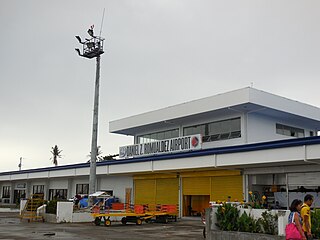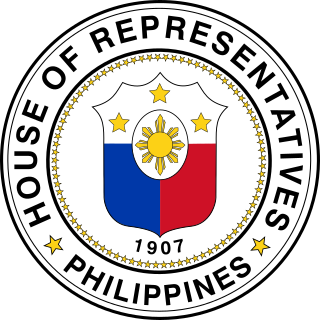
The United States Department of Transportation is a federal Cabinet department of the U.S. government concerned with transportation. It was established by an act of Congress on October 15, 1966, and began operation on April 1, 1967. It is governed by the United States Secretary of Transportation.

Laguindingan Airport is the main airport that serves the cities of Cagayan de Oro and Iligan, as well as the provinces of Misamis Oriental, Lanao del Norte and Bukidnon in Northern Mindanao, Philippines. It is classified as a Principal Domestic Airport Class 1 by the Civil Aviation Authority of the Philippines (CAAP), a body of the Department of Transportation (DOTr) responsible for implementing policies on civil aviation to assure safe, economic and efficient air travel, and the handling of operations at airports.

Daniel Z. Romualdez Airport, also known as Tacloban City Airport, is an airport serving the general area of Tacloban, a highly urbanized city in Leyte island in the Philippines. It is the main gateway from Manila and Cebu to the Eastern Visayas Region in central east Philippines. It is classified as a Class 1 principal airport by the Civil Aviation Authority of the Philippines, the agency responsible for the operations of all the airports in the Philippines excluding the major international airports. As of 2017, Daniel Z. Romualdez Airport is ranked as the eighth-busiest and the third-fastest growing airport by passenger volume out of the 45 commercial airports in the Philippines.

Calbayog Airport is an airport serving the general area of Calbayog, located in the province of Samar in the Philippines. The airport is classified as a Class 2 principal airport by the Civil Aviation Authority of the Philippines, a body of the Department of Transportation and Communications that is responsible for the operations of not only this airport but also of all other airports in the Philippines except the major international airports.

Catarman National Airport, otherwise known as Catarman Airport, is an airport serving the general area of Catarman, located in the province of Northern Samar in the Philippines. The airport is classified as a Class 2 principal airport by the Civil Aviation Authority of the Philippines, a body of the Department of Transportation and Communications that is responsible for the operations of not only this airport but also of all other airports in the Philippines except the major international airports.

Bicol International Airport is an under-construction international airport that will serve Legazpi, the capital city of Albay and the regional center of Bicol Region, in the Philippines.

Sanga-Sanga Airport, also known as Tawi-Tawi Airport, is an airport serving the general area of Bongao, the capital of the province of Tawi-Tawi in the Philippines. The airport is classified as a Class 2 principal airport by the Civil Aviation Authority of the Philippines, a body of the Department of Transportation and Communications that is responsible for the operations of not only this airport but also of all other airports in the Philippines except the major international airports. It is not an international airport, contrary to its classification by the Tawi-Tawi provincial government. It is located on Sanga-Sanga Island. The airport was referenced by IATA with the code SGS until the end of 2011.
The Legislative Districts of Northern Samar, namely the first and second districts, are the representations of the Province of Northern Samar in the Philippine House of Representatives. Northern Samar was represented as part of the first district of Samar until 1967, and of Region VIII from 1978 to 1984. From 1984 to 1986 it elected 2 assemblymen at-large. In 1986 it was redistricted into two legislative districts.

The Civil Aviation Authority of the Philippines is the national aviation authority of the Philippines and is responsible for implementing policies on civil aviation to assure safe, economic and efficient air travel. The agency also investigates aviation accidents via its Aircraft Accident Investigation and Inquiry Board. Formerly Air Transportation Office, it is an independent regulatory body attached to the Department of Transportation for the purpose of policy coordination.

Cesar Lim Rodriguez Airport, also known as Taytay Airport, Sandoval Airport or Taytay–Sandoval Airport, is an airport serving the general area of Taytay, located in the province of Palawan in the Philippines. The facility was named after Taytay native Cesar Lim Rodriguez, a former judge who donated part of his property for the airport.

Bohol–Panglao International Airport, also known as New Bohol International Airport, is a new airport on Panglao Island in the province of Bohol, Philippines. It replaced Tagbilaran Airport to support Bohol's increased passenger traffic due to tourism.
Quirino Airport is a planned airport that would serve the whole province of Quirino, in the municipality of Maddela.
Libmanan Airport is a planned airport that would serve the municipality of Libmanan and also the Province of Camarines Sur in the Philippines.

The Sixteenth Congress of the Philippines was the meeting of the national legislature of the Republic of the Philippines, composed of the Senate and House of Representatives. The convention of the 16th Congress was followed by the 2013 Senate election, which replaced half of the Senate membership, and the 2013 House of Representatives elections which elected the entire membership of the House of Representatives.

The Department of Information and Communications Technology is the executive department of the Philippine government responsible for the planning, development and promotion of the country's information and communications technology (ICT) agenda in support of national development.

Pantaleon "Bebot" Diaz Alvarez is a Filipino politician and the Speaker of the House of Representatives of the Philippines from 2016 to 2018, and represents the 1st District of Davao del Norte, the Philippines. He is a stern advocate to shift the current centralized set-up of the Philippines into a federal form, pushing for the establishment of an indigenous state in Luzon and an indigenous state in Mindanao.

The Anti-Distracted Driving Act, officially recorded as Republic Act No. 10913, is a law in the Philippines that prohibits distracted driving by restricting and penalizing the use of mobile phones and other electronics devices while driving on any public thoroughfare, highway or street in the Philippines. The republic act defines "distracted driving" as "using mobile communications device to write, send, or read a text-based communication or to make or receive calls" or "using an electronic entertainment or computing device to play games, watch movies, surf the internet, compose messages, read e-books, perform calculations, and other similar acts" while behind the wheel of a moving vehicle or while temporarily stopped at a red light. The law covers all private and public vehicles, including agricultural machines, construction equipments, public utility buses and jeepneys, taxicabs, motorcycles, tricycles, pedicabs, kuligligs and carriages.
















